Wheat and the Distorted Views of William Davis
William Davis, a cardiologist, author of Wheat Belly, claims that “modern wheat is a perfect chronic poison”. He claims that modern wheat causes diabetes, inflammation, heart disease and high blood pressure and that eliminating wheat will cure these problems.
Davis recommends the avoidance of foods such as corn, rice, quinoa, millet, buckwheat, beans and potatoes – even though they do not contain wheat or gluten.
Davis’s inconsistencies would be amusing if they did not have such serious health consequences.
Wheat
Maize, wheat and rice are the most commonly grown cereal crops.
Common bread wheat, Triticum aestivum, has one of the most complex genomes known with 6 copies of each chromosome (that is, a hexaploid variety) and approximately 5 times the number of genes of humans.
The history of wheat evolution is complex. There is little agreement on what constitutes a true history of wheat. There are many different synonyms for species and subspecies and disagreements on what constitutes a species or subspecies. One item that is in agreement is that gliadins and gluten were present millions of years ago. 1 2
Gamma-gliadin is found in goat grass from which the gliadins in modern wheat are derived. 3
Gliadin is present in all wheat, wild and cultivated. 4
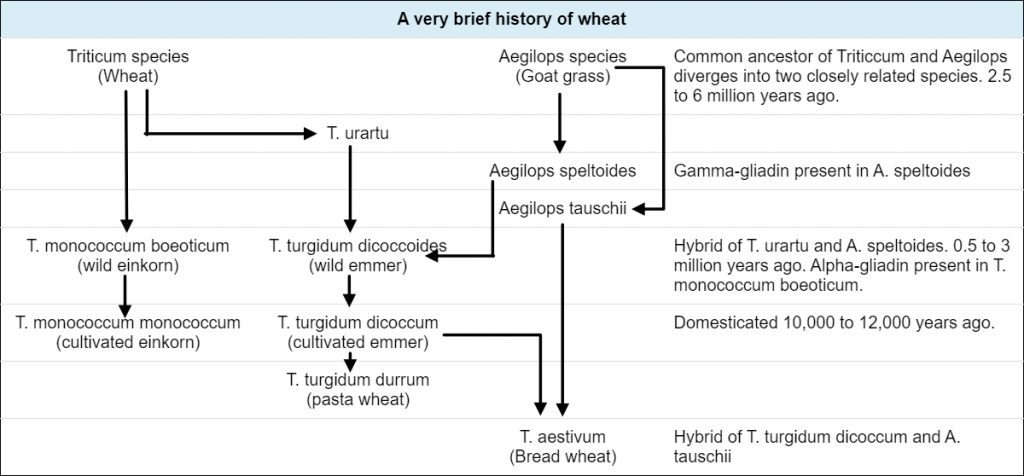
Davis’s version of the origin of gliadin is several million years late.
Common or Bread Wheat
Triticum aestivum, a hexaploid species which is usually called “common” or “bread” wheat. It accounts for 95% of the wheat grown. Bread wheat is was probably formed 8,000-9,000 years ago in southeast Turkey from a hybrid of a variety of Durum wheat (Emmer), Triticum turgidum, and a closely related grass, Goat grass, Aegilops tauschii, that originally shared a common ancestor with wheat.
Pasta or Durum Wheat
Triticum turgidum var. durum, a tetraploid (four chromosomes) species is gown in the Mediterranean regions and adapted to hot, dry summer conditions. This accounts for most of the remaining 5%.
Einkorn
Cultivated Einkorn is a diploid (two sets of chromosomes, one from each parent) wheat variety, Triticum monococcum var. monococcum. The origins of wheat varieties are disputed. South-east Turkey, the northern part of Tigris-Euphrates, the Balkans and Jordan near the Dead Sea is considered as a likely region. Wild Einkorn, Triticum boeoticum, is a different species.
Wild einkorn was found in modern Turkey, south Caucasian region, the Mediterranean region, southwestern Europe and the Balkans. It was one of the first cereals cultivated for food. Wild einkorn grain was harvested from 16,000-15,000 BC. Domestication of einkorn occurred around 7,500 BC (9,500 to 10,000 years ago). Einkorn continued to be grown widely until 4,000 BC before emmer wheat become more popular.
Einkorn cultivation continued in isolated regions to the current day where it is limited to small regions within France, India, Italy, Turkey and Yugoslavia.
Emmer
Modern Emmer wheat is also known as Farro, is a tetraploid (four set of chromosomes) variety, Triticum turgidum var. dicoccum – a variety of pasta wheat. Einkorn wheat and emmer wheat were the first crops domesticated in the grassland and woodland areas from Israel to Iran.
Spelt
Spelt (Triticum aestivum var. spelta) is considered to be a variety of common wheat. It appears to originate in the southern Caucasus Mountains region of Georgia, Armenia and Azerbaijan approximately 6,000 BC. 5
Khorasan
Khorasan or Oriental wheat, Triticum turgidum ssp. turanicum, is similar to Emmer. Kamut is its registered name. It was first described in 1921 in the Persian province of Khorasan. 6
It is generally considered an ancient relative of Triticum turgidum var. durum. 7
Khorasan wheat has greater amount of gliadin than modern wheat. 7
Gluten and Gliadin
Gluten is a group of proteins found in wheat, barley, rye and oats. Glutens are classified as either prolamins or glutelins. It is common not to include oats as a gluten source.
There is more of a similarity with wheat, barley and rye glutens than oats. This is why some people who react to wheat, barley and rye are able to eat oats. There is the added complication that oats may be contaminated with other cereals.
The table classifying glutens is based on Schalk et al 2017. 8
| Gluten | Collective name for storage proteins found in cereals. | ||
|---|---|---|---|
| Prolamins | Simple proteins - soluble in alcohol | ||
| Gliadins | Wheat | ||
| Secalins | Rye | ||
| Hordeins | Barley | ||
| Glutelins | Complex proteins - insoluble in water and alcohol | ||
| Glutenins | Wheat | ||
| Secalins | Rye | ||
| Hordenins | Barley | ||
| Non-Gluten Proteins | |||
| Prolamins | Prolamins are plant storage proteins having high levels of the amino acids proline and glutamine amino acid content. They are found in cereal grains. Examples include corn (zein), sorghum (kafirin) and oats (avenin). | ||
| Glutelins | Complex proteins - insoluble in water and alcohol. Includes oats (avenalins), corn (zeanins), rice (oryzenin), soy glutelins and millet glutelins. | ||
Gluten creates the elasticity of the kneaded dough which is important for making bread, pasta and other wheat-based products.
According to Davis:
Davis makes no support for his claims that wheat is associated with the diseases that he mentions other than anecdotal evidence. I have addressed the conditions that Davis raises in other posts.
- Type 1 diabetes The problem with cow’s milk
- Rheumatoid arthritis Rheumatoid arthritis – An autoimmune condition
- Multiple sclerosis Multiple Sclerosis and Roy Swank
According to Davis,
Modern wheat is a perfect, chronic poison.
[Wheat today] is an 18-inch tall plant created by genetic research in the ’60s and ’70s. This thing has many new features nobody told you about, such as there’s a new protein in this thing called gliadin. It’s not gluten. I’m not addressing people with gluten sensitivities and celiac disease. I’m talking about everybody else because everybody else is susceptible to the gliadin protein that is an opiate. This thing binds into the opiate receptors in your brain and in most people stimulates appetite, such that we consume 440 more calories per day, 365 days per year. It’s really a wheat issue. 10Davis makes the claim that “gliadin is not gluten”. Incorrect. Gliadin is relatively simple protein that is a component of all wheat gluten.
Davis claims that gliadin is an opiate as it binds to opiate receptors. An opiate is a drug derived from opium. Binding to an opiate receptor does not make a substance an opiate. Davis relies on the paper 11 to support his claim that gliadin is an opiate. However, the paper states that “wheat gluten, alpha and beta caseinates and hemoglobin” bind with opiate receptors.
William Davis ignores that fact that alpha and beta caseinates found in dairy and cheese and hemoglobin found in meat, also binds to opiate receptors.This is because dairy, red and processed meat are acceptable foods, according to Davis.
A simpler explanation of the rising rate of obesity is that we are eating more and whilst the amount of fat as a proportion of food has dropped from an average of 40% to 33%, the total amount of fat has actually increased.
Even the so-called Subway Diet has been associated with significant weight loss. The core component of this diet was whole-grain Subway sandwiches without the cheese or mayonnaise.
Whole-grain bread is (or was in the 1960s) an important part of the diet in the Greece and the Mediterranean regions of Spain and France comprising of 30-40% of energy intake. Bread consumption was less in Italy because “they eat so much pasta”. 12
Approximately 5% of the population has some kind of issue consuming wheat or gluten products. For the remainder of the population, large-scale studies have shown that the consumption of grains provides a significant health benefit.
Glycemic Index and Whole-Grain Bread
Davis states that “Whole wheat bread has a GI of 72 which is higher than table sugar (GI = 59)“. This is true but very misleading.
Glycemic index compares the blood glucose response over a two hour period obtained from 50 g of available carbohydrate (dietary fibre is not included) in the test food to the blood glucose response obtained from 50 g (12 teaspoons or 60 ml) of glucose. Sugar (sucrose) contains 50% of high GI glucose and 50% of low GI fructose.
It takes 5-6 slices of whole-grain bread to obtain 50 g of carbohydrate.
The measurements are taken with isolated food components. In real life, food is not eaten in isolation but in combination with other foods which changes the GI significantly and cannot be predicted from the GI of the individual foods. Fruits that are ripe have a higher GI. Finely ground foods (such as flour) produce smaller particle sizes that results in increases to the glycemic index.
Cooking and cooling changes the food’s GI. Starch gelatinisation breaks the bonds of starch molecules when cooking with heat and water which makes the starch easier to digest. This process is reversed when the starch is cooled. Potatoes are a great example which is why hot cooked potatoes have a higher GI than potatoes cooled overnight. 13
The ripeness of the food changes the GI. Removing fibre from a food and grinding food to produce smaller particle sizes makes the food more readily absorbed which increases the GI. Mixing foods together, which we do when we eat food, results in a glycemic response that cannot be predicted.
Comparing the glycemic index of 5-6 slices of whole-grain bread to 60 ml sucrose is not a valid comparison.
Ideal Diet – According to Davis
Davis claims that gliadin, which is found in wheat, is the culprit. However, he advocates eliminating not only wheat – both traditional and modern, but rye, barley and oats. If gliadin was the culprit, then oats, barley and rye would be safe to consume.
Davis fails to explain why the elimination of foods such as corn, rice, quinoa, millet, buckwheat, beans and potatoes is so important – after stating that gliadin is the monster that created our current health crisis.
Examples of Wheat Belly “healthy” recipes include:
- Bacon Wrapped Chicken Breasts Stuffed with Spinach, Mushrooms and Roasted Red Peppers
- Italian Sausage Frittata with 8 eggs and hot chicken or turkey sausage meat – ensure that the sausage casings are removed
- Pepperoni Bread made with pepperoni, eggs and cheese
Davis and The China Study
Davis claims that “Minger’s analysis of the China study data showed that wheat ingestion is responsible for the heart disease”. Denise Migner claims that Colin Campbell distorted data from China-Cornell-Oxford project (“The China Study”) and that the data really showed that wheat is responsible for heart disease. 14
Colin Campbell was a member of a team of researchers involved with The China Study. The epidemiologist and statistician was Sir Richard Peto from Oxford University. Junshi Chen of Beijing organised the survey teams that collected data including blood samples throughout China. Li Junyao was one of the authors of Chinese Cancer Atlas Survey – a comprehensive survey of the causes of mortality of the Chinese that covered 96% of the population.
Denise Migner at the time of her revelations was a 23 year-old who majored in English. She is a Catholic school teacher with no training in statistics, mathematics or epidemiology. On reviewing the China Study data, she discovered serious flaws which escaped the attention of not only Campbell but also Peto, Li and Chen.
According to Migner, 15 her intention ‘is to highlight the weaknesses of “The China Study” and the potential errors in Campbell’s interpretation of the original data’. It is not only Campbell’s interpretation but Peto’s, Li’s and Chen’s as well.
Migner, states that there exists a highly significant correlation between wheat flour consumption and two cardiovascular disease. She makes the observation that “none of these correlations appear to be tangled with any risk-heightening variables”.
Campbell makes the following points.
- Higher wheat consumption was associated with a lower consumption of green vegetables as many of these people live in northern, arid and much colder regions
- Tuoli county data was omitted, which Migner called a “sin of omission”. The data was omitted because the people of Tuoli county are nomadic which results in a high seasonal variation in meat consumption and fruit and vegetable consumption
- Consumption of wheat was associated with a lower serum levels of monounsaturated fats
- Consumption of wheat was associated with a greater body weight
- Consumption of wheat was associated with a higher serum levels of urea which is a marker of protein consumption
Weight Reduction
Consumption of whole-grains has been shown to correlate to weight reduction, not weight gain.
An eight-year study of men showed, “an increase in whole-grain intake was inversely associated with long-term weight gain”. 16
Similarly, a study of 74091 US female nurses aged 38–63 years in 1984 were assessed in 1984, 1986, 1990 and 1994. This showed that, “weight gain was inversely associated with the intake of high-fiber, whole-grain foods.” That is, the more whole-grains consumed, lower the weight gain. 17
Related articles
What is the Problem with Wheat?
Wheat and Inflammation
Impact of a Gluten-Free Diet
Wheat and the Distorted Views of William Davis
Glucose Tolerance – Comparison of High-Fat and High-Carb Diets
Last updated on Thursday 15 February 2024 at 05:20 by administrators
Footnotes
- Brouns, F. J. P. H. et al. (2013) Does wheat make us fat and sick? Journal of Cereal Science. 58 (2), 209–215.
- Stallknecht, G. F. et al. (1996) ‘Alternative Wheat Cereals as Food Grains: Einkorn, Emmer, Spelt, Kamut, and Triticale’, in J Janick (ed.) Progress in New Crops. Alexandria VA: ASHS Press. pp. 156–170.
- Goryunova, S. V. et al. (2012) Expansion of the gamma-gliadin gene family in Aegilops and Triticum. BMC Evolutionary Biology. 12 (1), 215
- Rasheed, A. et al. (2018) The goat grass genome’s role in wheat improvement. Nature Plants. 4 (2), 56–58.
- Cubadda, R. & Marconi, E. (2002) ‘Spelt wheat’, in Pseudocereals and Less Common Cereals. Springer. pp. 153–175.
- Grausgruber, H. et al. (2004) Khorasan wheat, Kamut and ‘Pharaonenkorn’: origin, characteristics and potential.
- Colomba, M. S. & Gregorini, A. (2012) Are Ancient Durum Wheats Less Toxic to Celiac Patients? A Study of α-Gliadin from Graziella Ra and Kamut. The Scientific World Journal. 20121–8.
- Schalk, K. et al. (2017) Isolation and characterization of gluten protein types from wheat, rye, barley and oats for use as reference materials Karol Sestak (ed.). PLOS ONE. 12 (2), e0172819.
- Davis, W. (2017) Dr. William Davis | Cardiologist & Author of Wheat Belly Books [online]. Available from: https://www.wheatbellyblog.com/(Accessed 15 October 2017).
- Cochran, A. (2013) Modern wheat a ‘perfect, chronic poison,’ doctor says – CBS News [online]. Available from: https://www.cbsnews.com/news/modern-wheat-a-perfect-chronic-poison-doctor-says/ (Accessed 26 June 2018).
- Möller, N. P. et al. (2008) Bioactive peptides and proteins from foods: indication for health effects. European Journal of Nutrition. 47 (4), 171–182.
- Keys, A. & Keys, M. (1975) How to eat well and stay well the Mediterranean way. Doubleday, Garden City, NY. p38
- Fernandes, G. et al. (2005) Glycemic index of potatoes commonly consumed in North America. Journal of the American Dietetic Association. 105 (4), 557–562.
- Davis, W. (2017) Dr. William Davis | Cardiologist & Author of Wheat Belly Books [online]. Available from: https://www.wheatbellyblog.com/ (Accessed 15 October 2017).
- Migner, D. (2010) The China Study: Fact or Fallacy? | Denise Minger [online]. Available from: https://deniseminger.com/2010/07/07/the-china-study-fact-or-fallac/.
- Koh-Banerjee, P. et al. (2004) Changes in whole-grain, bran, and cereal fiber consumption in relation to 8-y weight gain among men. The American Journal of Clinical Nutrition. 80 (5), 1237–1245.
- Liu, S. et al. (2003) Relation between changes in intakes of dietary fiber and grain products and changes in weight and development of obesity among middle-aged women. The American Journal of Clinical Nutrition. 78 (5), 920–927.
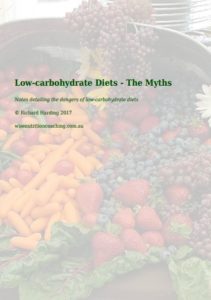
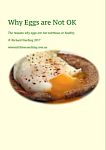
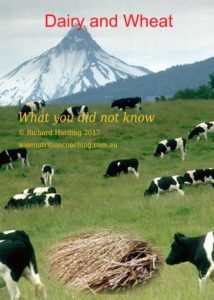
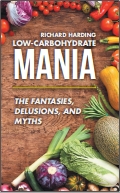


It is great that you have found a solution to your problems.
If people have really have developed a problem with modern wheat then it certainly is not for the reasons given by William Davis. May be there is also a problem with modern growing methods. Some additives to modern bread are particularly dangerous such as propionate salts. It can be really difficult to untangle the complexities of nutrition.
Check out the other posts listed at the end of the article.
What is the Problem with Wheat and Gluten? article describes the often cited Italian study from a Rome clinic that reported only 30% of those suffering from IBS were diagnosed at being sensitive to gluten. Many were sensitive to multiple food items.
The same article describes two Melbourne studies by the same research team. 32% of the patients reported an improvement, even when they were unknowingly consuming a gluten diet. 40% of the patients reported no improvement, even when they were unknowingly consuming a gluten-free diet.
Why does Davis insist on eliminating all grains when he contends that the consumption of modern wheat is the cause of the majority of health problems and that the elimination of wheat is first step in avoiding autoimmune diseases such as type 1 diabetes, rheumatoid arthritis and multiple sclerosis.
Davis states that gluten is an opiate. No. An opiate is a substance derived from the alkaloids of opium.
Davis claims that gliadin is an opiate as it binds to opiate receptors. The paper Davis cites to support his claim states that “wheat gluten, alpha and beta caseinates and hemoglobin” bind with opiate receptors. Binding to an opiate receptor does not make a substance an opiate.
Davis simply ignores that fact that caseinates are found in dairy and cheeses and hemoglobin found in meat also binds to opiate receptors. This is clearly stated in the same sentence so Davis is being dishonest. Dairy, red and processed meat are health foods, according to Davis. Check out his pepperoni bread and bacon-wrapped chicken breast recipes.
Richard
Interestingly, if I eat modern wheat, it makes me feel lethargic and generally crappy. But if I eat the ancient forms of same–especially when sour dough cultured, I don’t experience these symptoms. Something is going on.